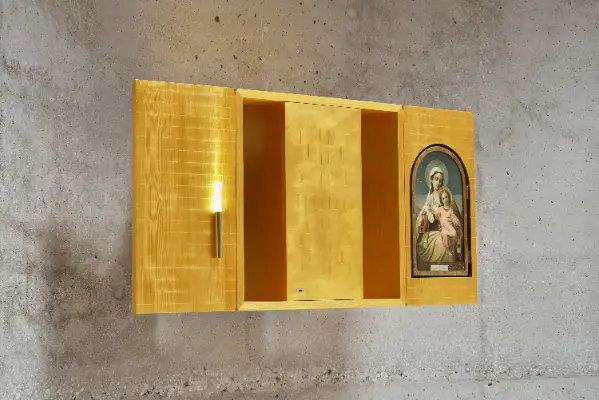马里博尔的博斯科教堂

下载所需积分: 2
博斯科教堂 “Don Bosco Church” 是2017年米斯·范德罗奖提名作品,位于斯洛文尼亚马里博尔的一个新教区中心,坐落在波霍尔耶山脉 “Pohorje Massif” 下的一个住宅区内。该地点俯瞰佩克尔斯卡·戈尔卡山 “Pekrska Gorca Mountain”。
该宗教综合体属于萨利西亚 “Salesian” 社区,设计为一个封闭的建筑岛,位于一个小公园内,保护着周围的两条道路。建筑本身是一个清晰的矩形建筑体,中央有一个内向的庭院,教堂的主堂和钟楼高耸于其上。
进入装饰有古老菩提树的沉思庭院时,教堂突然在门廊的另一侧显现出来。人们可以一眼看到主堂的规模,从建筑的低层屋顶延伸到代表皇冠的檐口。主堂的体量嵌入一层低建筑的结构中,其统一的砖砌外立面装饰有七个用釉面砖制成的十字架图案。
主堂的形状源自一个带有圆角和侧面的三角形。主堂是内向沉思的地方,因此唯一的视野是朝向天空。最神圣的地方因此被强烈的光线体验所标记。
我们使用了不同的光线质量来强调主堂的包围形状。我们编排了一场光的表演:从圆形天窗射入的生动自然光与主堂的漫射光相互交织。来自祭坛后方和后合唱团的柔和自然光也在流入。这种简单而复杂的设计使建筑超越了其物理存在,成为光的容器。
主堂的原始非装饰性结构通过柔和形状的混凝土的塑性得到了强调。主堂的椭圆周边设有水平侧凹槽,容纳了带圣体匣的侧小教堂、通往圣器室的入口、告解室、侧合唱团和后合唱团以及共融祈祷的地方。这些开口使人感受到围绕中央天窗的宁静旋转感。
教堂可容纳300人,座位为木制长椅。地面铺设了厚重的橡木地板,而100个手工制作的陶土灯则形成了上方的地平线。橡木装饰和陶土灯等温暖材料为教会社区创造了安全的避风港。我们还设计了所有的礼仪设备,如祭坛、讲台、圣体匣、座椅、长椅和艺术品的布局。
侧小教堂中的圣体匣是一个三联画,外翼遮盖中央柜子。圣体匣分两步打开:当外翼关闭时,露出一个漂浮的金色矩形。打开两个侧翼后,内部的神秘光源——永恒之光——显现出来。内圣体匣装饰着一幅珍贵的图标——来自都灵基督徒助佑圣母大教堂的前圣体匣门,这座教堂是由约翰·博斯科建造的。
Nominated for the Mies van der Rohe Award 2017.
The Don Bosco Church is part of a new parish centre, located in a residential quarter of Maribor, under the Pohorje Massif. The site boasts a view towards the Pekrska Gorca Mountain.
The Religious Complex belonging to the Salesian community is designed as a closed building island, placed inside a small park, which protects the complex of two nearby roads. The building itself is a clearly articulated rectangular architectural mass with an introverted central courtyard with the nave and the bell tower rising above it.
Upon entering the contemplative courtyard adorned by an old linden tree the church suddenly becomes visible across the portico. At a glance one can feel the extent of the nave from the ground over the roof of the lower part of the complex all the way to the cornice that represents a crown. The volume of the nave is set into the structure of the lower one story building. Its uniform brick facade is embellished with ornaments representing seven crosses made of glazed bricks.
The shape of the nave is derived from a triangle with rounded corners and sides. The nave is the place for introverted contemplation therefore the only view out is towards the sky. The most sacred place is thus marked by an intense experience of light.
We used different qualities of light in order to accentuate the hugging shape of the nave. We choreographed a play of light: vivid natural light emitting from the round skylight interferes with diffused light of the nave. More soft natural light is coming from behind the presbytery and the rear choir. This simple yet so complex design allows the building to transcend its physical presence, becoming a mere container of light.
Pristine non-decorated expression of the structure of the nave is accentuated by plasticity of softly shaped concrete. The oval perimeter of the nave features horizontal lateral recesses, which house the chapel with the tabernacle, entrance to the sacristy, confessionals, side and rear choirs and a place for communion prayers. These openings induce a feeling of peaceful rotation around the central oculus.
The church seats 300 people on wooden benches. The floor below is covered massive oak wood floor while 100 handmade clay lamps form the horizon above. Warm materials such as oak wood fittings and clay lamps create a feeling of safe haven for the church community. We also designed all the liturgical equipment, such as the altar, the ambo, the tabernacle, sedilia, benches and layout of the artworks.
Tabernacle, placed in the side chapel, is a triptych with outer wings veiling the central cabinet. The tabernacle opens in two sequential steps: when the wings are closed, they reveal a floating gold rectangle. Upon opening the two side wings the interior with the mysterious light source – the eternal light - is revealed. The inner tabernacle is adorned with a precious icon – former tabernacle doors from the Basilica of Our Lady Help of Christians, in Turin, which was built by John Bosco.